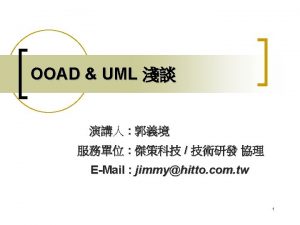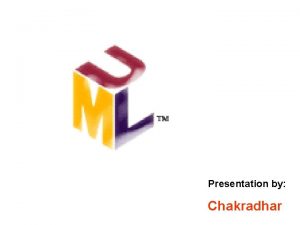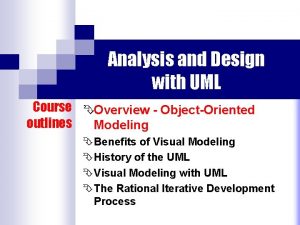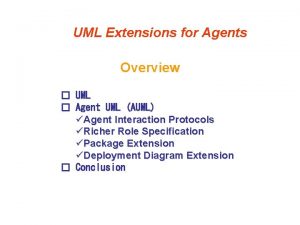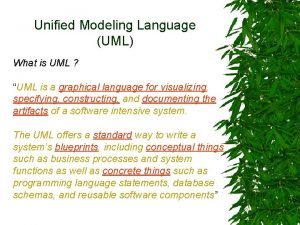UML an overview What is UML UML stands








- Slides: 8

UML – an overview What is UML? UML stands for Unified Modelling Language. ”The Unified Modelling Language is a visual language for specifying, constructing and documenting the artifacts of systems” [1]. It is an aid, a language, for communication within and of system development. UML is described in two official publications: [1] OMG, 2003, UML 2. 0 Infrastructure Specification, www. omg. org, [2] OMG, 2003, UML 2. 0 Superstructure Specification, www. omg. org UML consists of a number of diagrams with graphical notations which are used to model a system from different perspectives. UML is based on a model called Meta Modell. We can most of the time simplify and say that the Meta Model is synonymous with the UML language. What is not UML? UML is not a method itself, nor equivalent to objectoriented development. 1

UML – perspectives UML in different perspectives Conceptual perspective - To build up an understanding of, and a vocabulary for a certain domain - most often technically independent Software perspective - To describe the design and the implementation of a certain system - most often technically independent 2

UML – ways UML in different ways UML as sketch -- to describe parts of possible solutions of problems or a domain -- to discuss parts of existing solutions -- the idea is to use UML for a selective, more informal description of the system or the domain UML as blueprint - to describe the system in a way that a programmer can use - to document existing system solutions for more definite use - the idea here is to use UML for a complete and formal description of the system Code in UML - UML is the actual programming language and is compiled directly into code - the idea is to avoid the programming step between model and code - not entirely ready for general use in system development and to early to see if it is going to be widely used 3

UML – areas UML in different areas Before coding - the models are used as basic data for coding - forward engineering After coding - the models are used as documentation of the code - reverse engineering Round-trip -both of the fields of applacation above are used -- round-trip engineering As view-aid - the code is the source and UML is used to present the code when needed - tripless engineering 4

UML – a diagram overview UML 2. 0 has 13 diagram types, with different focus, and the types are divided into two main groups. Structure Diagrams describe static (structural) conditions. Behavioral Diagrams describe dynamic conditions. Structure Diagram (6 st) Diagram (13 st) Behavioral Diagram (7 st) 5

UML – Structure Diagrams Class Diagram Object Diagram Structure Diagram Packet Diagram Component Diagram Composite Structure Diagram Deployment Diagram 6

UML – Behavioral Diagrams Activity Diagram Use Case Diagram State Machine Diagram Behavioral Diagram Interaction Diagram Sequence Diagram Communication Diagram Interaction Overview Diagram Timing Diagram 7

The reality and UML-models Business processes (in Activity Diagram) Communication between people (in Sequence. Diagram) Business concepts (in Class Diagram) Use Case Activity Diagram Sequence Diagram Information modell (in Class Diagram) The reality UML-models 8


